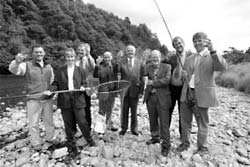| REVIEW OF SAWBILL DUCK MANAGEMENT ON THE SPEY Goosanders, red-breasted mergansers (known collectively as sawbill ducks) and cormorants are regarded as serious predators of salmon parr and smolts on the Spey, but are protected by the Wildlife & Countryside Act (1981).
Surveying on foot has been used in the past but this is time consuming and when undertaken over several days may double-count birds. With the enhanced status of salmon within the Spey candidate Special Area of Conservation, a fresh approach to managing sawbill ducks is being pioneered. The SFB is currently working with Dr. Peter Cosgrove (Cairngorms Biodiversity Officer), and Scottish Natural Heritage on improving sawbill monitoring and modifying licence applications. Canadian canoes are being used to cover the 116 km stretch from Loch Insh to Spey Bay and using this approach the distance can be covered in 3 – 4 hours. The efficiency of the technique allows more regular counts to be made and minimizes double counts providing better supporting information for management. SPEY CATCHMENT MANAGEMENT PLAN LAUNCHED The Spey is renowned for its purity and is of national and international importance for its salmon rod fishery, whisky distilling industry and wildlife. It also provides for major domestic and industrial water supplies, as well as a challenging environment for outdoor pursuits. This is also a time of considerable change for the River Spey in terms of policies and procedures. The establishment the Special Area of Conservation, the designation of the Cairngorms National Park and the implementation of the Water Framework Directive will all impinge on future management decisions. To address the need for improved and integrated management a Catchment Management Plan for the River Spey and its tributaries was launched on the 24th June 2003, followed by a ceremony held by the Spey Catchment Steering Group and hosted by the Malt Distillers Association Scotland at the Glenfiddich Distillery in Dufftown. The Spey Catchment Steering Group consists of representatives from the Spey Fishery Board, the Scottish Environment Protection Agency, Scottish Natural Heritage, Moray Council and Highland Council. Under the guidance of Project Officer, Kristin Scott, the Plan was produced following extensive public consultation over the last three years. The Plan sets out a blueprint for all interested parties to work together to ensure the long-term sustainable management of the Spey without undermining individual rights and responsibilities. The successful delivery of the Plan will safeguard the future of wild salmon stocks in the river and the fisheries which depend upon them. Copies of the Catchment Management Plan can be obtained from the Spey Fishery Board, Research Office, 1 Nether Borlum Cottage, Knockando, Morayshire, AB38 7SD, Tel 01340810841, email research@speyfisheryboard.com or Spey Catchment Steering Group, c/o Achantoul, Aviemore, PH22 1QD. Tel. 01479 810477, e-mail riverspey@snh.gov.uk, or it can be downloaded from www.snh.org.uk/pc-intro.htm. |
Welcome!Log into your account













